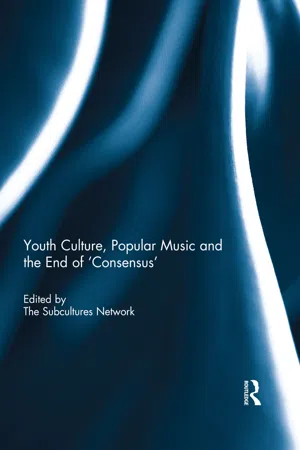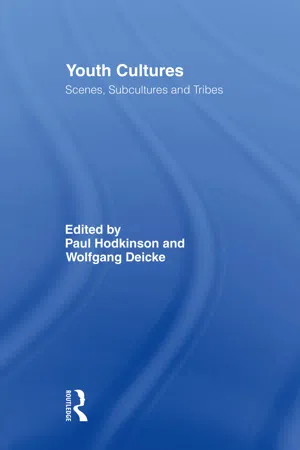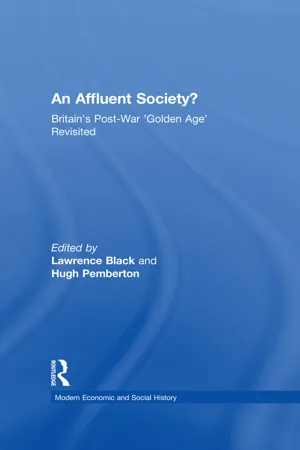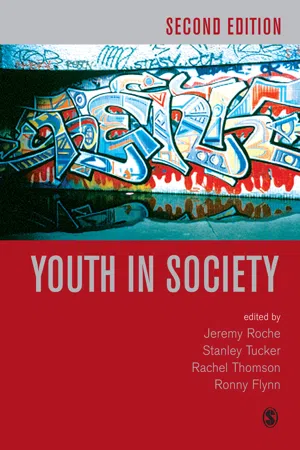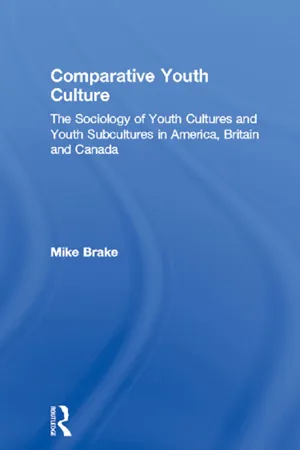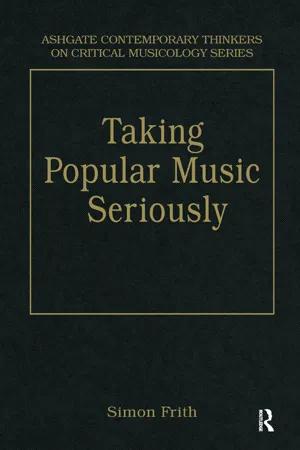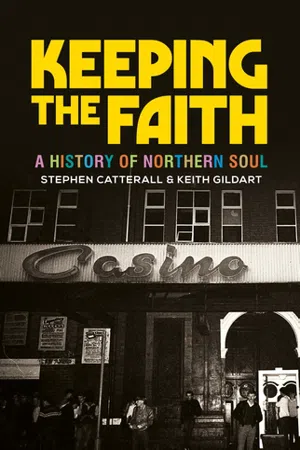British Youth Culture
British Youth Culture refers to the various subcultures and movements that have emerged among young people in the UK, such as the Mods, Rockers, Punks, and Ravers. These movements have been characterized by distinctive fashion, music, and social behaviors, often serving as a form of rebellion or self-expression. British Youth Culture has had a significant impact on fashion, music, and societal norms.
7 Key excerpts on "British Youth Culture"
- The Subcultures Network, The Subcultures Network(Authors)
- 2018(Publication Date)
- Routledge(Publisher)
...Indeed, the emergence of such easily recognisable subcultural ‘types’ as teddy boys, rockers, beats, teeny-boppers, mods, hippies, skinheads, suedeheads, soul boys and punks all but invited social commentary as to their rationale, purpose and significance. Similarly, the infusion of black cultural influences into the sites, sounds and styles of British Youth Culture added a further dimension to both its appeal and, in some cases, its perceived disrepute. But where, at least in the 1960s, the social and generational tensions afforded by such developments were partly offset by the technological and economic advances of the period, so the social and political discontent fanned by Britain’s mounting economic problems soon led to the more sanguine readings of youth culture to be buried beneath fears of hooliganism and moral degeneracy. In other words, the ‘youth question’—and thus the meanings, consequences and impulses that drove youth culture—informed wider debates as to problems of Britain’s present and their implications for the future. Here, then, we intend to look at specific examples of the ways by which elements of youth culture and popular music informed, reflected and responded to a period of notable social, economic and political change. More specifically, the articles contained in this edition of Contemporary British History relate to the period from the mid-to-late 1960s to the mid-1980s, during which the supposed consensus of Britain’s post-war polity first cracked and then collapsed under the combined weight of various economic factors, internal tensions and political-ideological realignment. First, we suggest that a focus on youth culture and popular music helps expose critical fault-lines in the very conception of a post-war consensus...
- eBook - ePub
Youth Cultures
Scenes, Subcultures and Tribes
- Paul Hodkinson, Wolfgang Deicke, Paul Hodkinson, Wolfgang Deicke(Authors)
- 2007(Publication Date)
- Routledge(Publisher)
...10 Youth culture and ethnicity Emerging youth interculture in South London Ben Gidley Black expressive culture has decisively shaped youth culture, pop culture and the culture of city life in Britain’s metropolitan centres. The white working class has danced for forty years to its syncopated rhythms. There is, of course, no contradiction between making use of black culture and loathing real live black people, yet the informal, long-term processes through which different groups have negotiated each other have intermittently created a ‘two-tone’ sensibility which celebrates its hybrid origins and has provided a significant opposition to ‘common-sense’ racism (Gilroy 1993b: 35.) At least since the emergence after World War II of the spectacular figure of the teenager, British Youth Culture has been a space of encounter and dialogue across lines of ethnicity. These lines of ethnicity have been perhaps less carefully patrolled than in adult culture, and thus youth culture has also been the site onto which adult culture has projected anxieties about ‘race’ and difference and Britain’s ‘multicultural drift’ (Hall 2001:231). This story has been the focus of much writing about youth culture since Dick Hebdige’s seminal work at the Birmingham Centre for Cultural Studies (1974a, 1974b, 1979, 1982, 1983). In a series of important occasional papers and in Subculture: The Meaning of Style, Hebdige explored the subterranean dialogue between black and white young people which took place in the spaces of youth culture, and in particular in skinhead style which was based on a passion for Jamaican and African-American music...
- eBook - ePub
An Affluent Society?
Britain's Post-War 'Golden Age' Revisited
- Lawrence Black, Hugh Pemberton(Authors)
- 2017(Publication Date)
- Routledge(Publisher)
...This new sense of youth and the attendant disposable income provided more opportunity for young people to experiment with different lifestyles in their consuming activities. Simultaneously these new developments in youth culture provided commerce with increasing reason to pursue youth as a market. For the early parts of the 1950s, however, youth in Britain appeared to have initiated only deviant and troublesome subcultures. Newsworthy youth themes concentrated on the gang violence of the Teddy Boys and increases in incidences of youth crime. 13 At this point, except for the enlightened entrepreneur, young people were widely perceived by commerce as a problem and far from an accessible market. However, by the late 1950s this situation slowly began to change. The press began to switch direction and to depict young people as ‘teenagers’, a new strand to youth culture that had first appeared in America. This new conception of British youth portrayed young people in an altogether more favourable light. Presented as more docile, conformist and fun-loving, ‘teenagers’ with their passion for records, dancing and dressing-up, began to appear as the kind of youth culture that could constitute a market. 14 The first serious attempt to exploit this emerging market on a broad scale in Britain was a market research report published by Mark Abrams in 1959 titled The Teenage Consumer. Mainly because Abrams was keen on showing the spending potential of young people, his study focused on those young people who had left full-time education and had not yet married. These 15-25-year-olds represented those young people with the greatest disposable income. Using the Ministry of Labour’s Census of Wages for April and October of 1958 and the Blue Book on National Income and Expenditure, Abrams arrived at the conclusion that Britain’s wage-earning youngsters were drawing about £1,480 millions annually, which equated to 8.5 per cent of all personal income in Britain...
- eBook - ePub
Youth in Society
Contemporary Theory, Policy and Practice
- Jeremy Roche, Stanley Tucker, Ronny Flynn, Rachel Thomson(Authors)
- 2004(Publication Date)
- SAGE Publications Ltd(Publisher)
...(1976) who agreed that not only is culture the level at which different groups develop patterns and relationships, but more importantly, it is how these experiences are expressed. That is, we can see culture as a means of social interaction and expression. And what of ‘youth’? To merely see it as the period between the ages of 12 and 20 is both misleading and inadequate. ‘Youth’ goes some way towards bridging the gap between the dependency of childhood and the independent ‘freedom’ of adulthood, and in order to combat the marginal social status and sense of powerlessness attributed to ‘youth’, it becomes its own social institution with its own codes and cultural claims. As a result, it poses a threat to the accepted norms of adult society. ‘Youth’ is, therefore, the point where the dominant culture loosens the control of its young, and ‘youth culture’ is the result. And, as it is on the streets that most young people make themselves visible in their attempts to express their independence from adult society, it is ‘the streets’ that enable the creation of these cultural activities. This ‘culture’ interacts on the streets, and finds its expression in the style it adopts. The high visibility of a group of young people with shared musical preferences, fashion ideals, and beliefs leads to the creation of a ‘sub-culture’. The main characteristic of any emerging sub-culture is that it captures the social, political and economic spirit of the time. Its members translate whatever is going on around them into the music, fashion and behaviour they use to identify themselves. Punk, for example, ‘dramatised rage’ (Coon, cited in Lydon, 1993: 79). Whether this was rage against the existing musical establishment or rising unemployment, didn’t matter. It was a feeling that was being expressed. This also may be why Punk affiliated itself closely with Rastafarians...
- eBook - ePub
Comparative Youth Culture
The Sociology of Youth Cultures and Youth Subcultures in America, Britain and Canada
- Mike Brake(Author)
- 2013(Publication Date)
- Routledge(Publisher)
...Chapter 3 Just another brick in the wall. British studies of working-class youth cultures American subcultural theory has been viewed as inappropriate to Britain by many British subcultural theorists. Downes (1966) argues that American theory is intrinsic to its own culture, whilst the British working classes have their own highly developed historical traditions. The British social structure is more historically class-conscious, and most British people can tell another's class origins and length of education by accent alone. Britain lacks the neo-colonial immigrant past of the United States. Its non-white groups are recent immigrants, and it does not have a long history of nationally born, impoverished, ethnic minorities who contribute to the myth that the poor are non-white. Youth cultural studies have focused on school, the working-class neighbourhood and local peer groups. Gangs have been less closely studied, and usually in the context of activities other than delinquency alone. While gangs tend to be informally structured ‘near groups’, composed of a closely linked core with a looser network of peripheral members, subcultures have been seen as wider than this. They are the constellations of actions, values, style, imagery and even life styles which, through media reportage, extend beyond a neighbourhood to form a complex relationship with other larger cultures, to form a symbolic pseudo-community. Subcultural theory has developed considerably since the post-war period. There are four approaches: firstly, the early social ecology of the late 1950s and early 1960s; secondly, the development of studies related to the sociology of education. This examines the relationship between youth, leisure and youth culture as an alternative to academic achievement. Thirdly, there are contemporary neighbourhood studies looking at local youth groups in the context of social reaction and labelling...
- eBook - ePub
Taking Popular Music Seriously
Selected Essays
- Simon Frith(Author)
- 2017(Publication Date)
- Routledge(Publisher)
...Britain has a long tradition of jazz, blues, soul and other musical freaks – hence fanzines (and rock critics). Such groups are composed of scholars, interested in fact and document, functioning less as a group than as a network of communication, but such purists may meet to play and listen to their music (as did the Stones and other early sixties blues fans) in their own clubs, pubs and halls. Britain is scattered with jazz clubs and folk clubs, with rock’n’roll nights and country evenings. For their participants music is more than a casual accompaniment of leisure, it is leisure’s purpose. 34 The most interesting of such groups in youth culture is that revolving around Northern Soul and its life of all-night dancing to obscure black music. It has been estimated that this scene has 25,000 adherents (I had one in my Keighley sample), many of whose leisure time is concerned entirely with soul music: I can’t stand to be with who doesn’t like soul... whole life centres around soul.... I couldn’t imagine going out with a girl who didn’t like soul... I like Black films and I like the life-style that they depict. Soul has given me so much that me and my girl have contemplated adopting a black baby.... The Northern Soul scene draws its members from the same sources as the non-musical deviant youth groups. It has continuities with both the mods (in its emphasis on dancing, its use of pills, its soul cult) and the skinheads (in its self-conscious anti-progressive and proworking-class stance) but the differences reveal what a sub-culture looks like when it’s really focused on music! 35 In the last chapter I suggested that sociologists of youth, whether approaching young people as consumers, adolescents or deviants, end up with a sociology of choice. In looking at the explanations of youth’s use of music we can see some of the difficulties that result from this focus on choice...
- eBook - ePub
Keeping the faith
A history of northern soul
- Keith Gildart, Stephen Catterall(Authors)
- 2020(Publication Date)
- Manchester University Press(Publisher)
...179–96. 17 For example, see Gildart, Images of England. 18 Dominic Sandbrook, White Heat: A History of Britain in the Swinging Sixties (London: Allen Lane, 2006); State of Emergency: The Way We Were: Britain, 1970–74 (London: Allen Lane, 2010); Seasons in the Sun: The Battle for Britain, 1974–79 (London, Allen Lane, 2012). For a flawed attack on the ‘myths’ of popular music written through a middle-class Oxbridge prism, see Fowler, Youth Culture in Modern Britain. 19 For examples, see Gildart, Images of England ; Matt Worley, No Future: Punk, Politics and British Youth Culture (Cambridge: Cambridge University Press, 2017); The Subcultures Network (ed.), Youth Culture and Social Change: Making a Difference by Making a Noise (Basingstoke: Palgrave Macmillan, 2017). 20 For an excellent recent example of the importance of dance in twentieth-century British history, see James Nott, Going to the Palais: A Social and Cultural History of Dancing and Dance Halls in Britain, 1918–1960 (Cambridge: Cambridge University Press, 2015). 21 See, for example, Peter Grant, National Myth and the First World War in Modern Popular Music (Basingstoke: Palgrave Macmillan, 2017). 22 See, for example, Peter Hennessey, Having It So Good: Britain in the Fifties (Harmondsworth: Penguin, 2006). 23 For a recent and much-needed empathetic general history of the working class, see Selina Todd, The People: The Rise and Fall of the Working Class 1910–2010 (London: John Murray, 2014). 24 For an idiosyncratic imagining of the history of the north, see Paul Morley, The North (and almost everything in. it) (London: Bloomsbury, 2013). 25 Dave Russell, Looking North: Northern England and the National Imagination (Manchester: Manchester University Press, 2004)...
